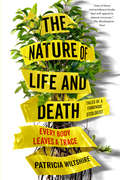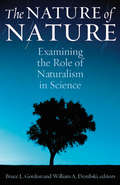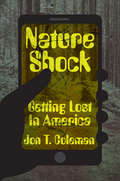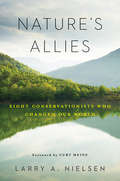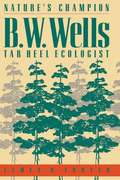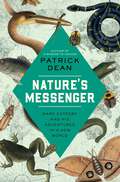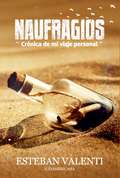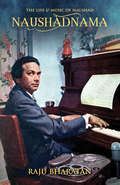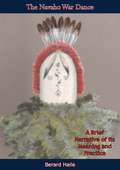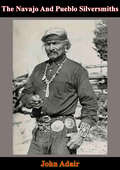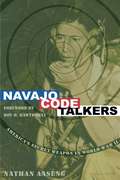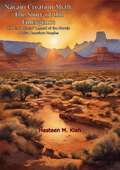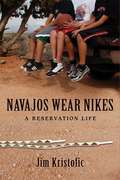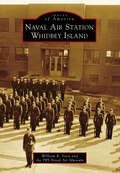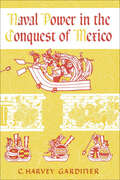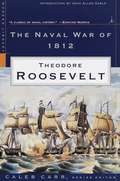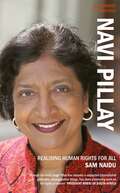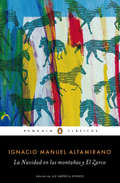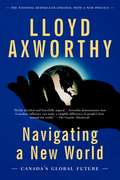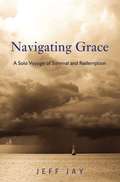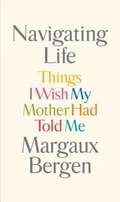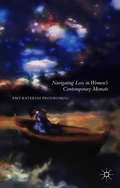- Table View
- List View
The Nature of Life and Death: Every Body Leaves a Trace
by Patricia WiltshireA riveting blend of science writing and true-crime narrative that explores the valuable but often shocking interface between crime and nature--and the secrets each can reveal about the other--from a pioneer in forensic ecology and a trailblazing female scientist.From mud tracks on a quiet country road to dirt specks on the soles of walking boots, forensic ecologist Patricia Wiltshire uses her decades of scientific expertise to find often-overlooked clues left behind by criminal activity. She detects evidence and eliminates hypotheses armed with little more than a microscope, eventually developing a compelling thesis of the who, what, how, and when of a crime. Wiltshire's remarkable accuracy has made her one of the most in-demand police consultants in the world, and her curiosity, humility, and passion for the truth have guided her every step of the way.A riveting blend of science writing and true-crime narrative, The Nature of Life and Death details Wiltshire's unique journey from college professor to crime fighter: solving murders, locating corpses, and exonerating the falsely accused. Along the way, she introduces us to the unseen world all around us and underneath our feet: plants, animals, pollen, spores, fungi, and microbes that we move through every day. Her story is a testament to the power of persistence and reveals how our relationship with the vast natural world reaches far deeper than we might think.
The Nature of Nature: Examining the Role of Naturalism in Science
by William Dembski Bruce GordonThe intellectual and cultural battles now raging over theism and atheism, conservatism and secular progressivism, dualism and monism, realism and antirealism, and transcendent reality versus material reality extend even into the scientific disciplines. This stunning new volume captures this titanic clash of worldviews among those who have thought most deeply about the nature of science and of the universe itself.Unmatched in its breadth and scope, The Nature of Nature brings together some of the most influential scientists, scholars, and public intellectuals--including three Nobel laureates--across a wide spectrum of disciplines and schools of thought. Here they grapple with a perennial question that has been made all the more pressing by recent advances in the natural sciences: Is the fundamental explanatory principle of the universe, life, and self-conscious awareness to be found in inanimate matter or immaterial mind? The answers found in this book have profound implications for what it means to do science, what it means to be human, and what the future holds for all of us.
Nature Shock: Getting Lost in America
by Jon T. ColemanAn award‑winning environmental historian explores American history through wrenching, tragic, and sometimes humorous stories of getting lost The human species has a propensity for getting lost. The American people, inhabiting a mental landscape shaped by their attempts to plant roots and to break free, are no exception. In this engaging book, environmental historian Jon Coleman bypasses the trailblazers so often described in American history to follow instead the strays and drifters who went missing. From Hernando de Soto&’s failed quest for riches in the American southeast to the recent trend of getting lost as a therapeutic escape from modernity, this book details a unique history of location and movement as well as the confrontations that occur when our physical and mental conceptions of space become disjointed. Whether we get lost in the woods, the plains, or the digital grid, Coleman argues that getting lost allows us to see wilderness anew and connect with generations across five centuries to discover a surprising and edgy American identity.
Nature's Allies: Eight Conservationists Who Changed Our World
by Larry NielsenIt's easy to feel powerless in the face of big environmental challenges—but we need inspiration more than ever. With political leaders who deny climate change, species that are fighting for their very survival, and the planet's last places of wilderness growing smaller and smaller, what can a single person do? InNature's Allies, Larry Nielsen uses the stories of conservation pioneers to show that through passion and perseverance, we can each be a positive force for change.In eight engaging and diverse biographies—John Muir, Ding Darling,Aldo Leopold, Rachel Carson, Chico Mendes,Billy Frank Jr., Wangari Maathai, and Gro Harlem Brundtland—we meet individuals who have little in common except that they all made a lasting mark on our world. Some famous and some little known to readers, they spoke out to protect wilderness, wildlife, fisheries, rainforests, and wetlands. They fought for social justice and exposed polluting practices. They marched, wrote books, testified before Congress, performed acts of civil disobedience, and, in one case, were martyred for their defense of nature.Nature's Alliespays tribute to them all as it rallies a new generation of conservationists to follow in their footsteps.These vivid biographies are essential reading for anyone who wants to fight for the environment against today's political opposition. Nature's Allies will inspire students, conservationists, and nature lovers to speak up for nature and show the power of one person to make a difference.
Nature's Champion
by James R. TroyerThrough the pioneering efforts of ecologist B. W. Wells (1884-1978), thousands of North Carolinians learned to appreciate and protect the state's diverse plant life long before ecology and conservation became popular causes. A keen observer of the natural landscape, Wells provided the first scientific descriptions in modern terms of the forces that shaped coastal communities, bogs and savannahs, the Carolina bays, pine forests, old fields, and mountain grassy balds. But the broader impact of his life lay in his championship and popularization of nature. Outside academic circles, he shared his knowledge through public lectures, articles, and lobbying efforts, and by teaching anyone who would listen. In 1932 he produced for his Tar Heel audience a revolutionary work on the plant ecology of the state, The Natural Gardens of North Carolina. Organized by habitat, this volume is still entertaining and instructive. Wells received his Ph.D. in botany from the University of Chicago in 1917 and served as chair of the North Carolina State College botany department for thirty years. He was a memorable teacher and a significant force in the development of his academic institution.
Nature's Messenger: Mark Catesby and His Adventures in a New World
by Patrick DeanA dynamic and fresh exploration of the naturalist Mark Catesby—who predated John James Audubon by nearly a century— and his influence on how we understand American wildlife.In 1722, Mark Catesby stepped ashore in Charles Town in the Carolina colony. Over the next four years, this young naturalist made history as he explored deep into America&’s natural wonders, collecting and drawing plants and animals which had never been seen back in the Old World. Nine years later Catesby produced his magnificent and groundbreaking book, The Natural History of Carolina, the first-ever illustrated account of American flora and fauna. In Nature&’s Messenger, acclaimed writer Patrick Dean follows Catesby from his youth as a landed gentleman in rural England to his early work as a naturalist and his adventurous travels. A pioneer in many ways, Catesby&’s careful attention to the knowledge of non-Europeans in America—the enslaved Africans and Native Americans who had their own sources of food and medicine from nature—set him apart from others of his time. Nature&’s Messenger takes us from the rice plantations of the Carolina Lowcountry to the bustling coffeehouses of 18th-century England, from the sun-drenched islands of the Bahamas to the austere meeting-rooms of London&’s Royal Society, then presided over by Isaac Newton. It was a time of discovery, of intellectual ferment, and of the rise of the British Empire. And there on history&’s leading edge, recording the extraordinary and often violent mingling of cultures as well as of nature, was Mark Catesby. Intensively researched and thrillingly told, Nature&’s Messenger will thrill fans of exploration and early American history as well as appeal to birdwatchers, botanists, and anyone fascinated by the natural world.
Naufragios: Crónica de mi viaje personal
by Esteban ValentiPersonaje polémico si los hay, Esteban Valenti se propone abrir esta "ventana de sinceridad" para exponer su camino vital, no exento de contradicciones, fallos y desengaños. Esteban Valenti plantea en este libro una revisión de su vida, las peripecias que ha tenido a lo largo de los años, y su participación en el accionar político desde diversos ámbitos. Se revela como una personalidad compleja, por momentos contradictoria, que ha dedicado la mayor parte de su existencia a la participación en la actividad política. Este libro finaliza analizando el fracaso del proyecto La Alternativa, y revelando los pormenores de ese proceso.
Naushadnama: The Life and Music of Naushad
by Raju BharatanThe seven letters in Naushad’s name are like the seven notes of Hindustani classical music. After just a few years in films, Naushad (1919-2006) went to rule the Hindi cinema music world for around two decades, beginning with the landmark Rattan (1944). His oeuvre (from 1940 to 2005) consists of an unmatched list of jubilees, many of which are musical milestones such as Andaz (1949), Baiju Bawra (1952), Mother India (1957) and Mughal-e-Azam (1960).No individual stays supreme without putting in tremendous efforts to reach the pinnacle and to stay there as long as possible, as our maestro did. And no composer probably moved so cleverly, behind the scenes, than did Naushad to sustain his hold on the public imagination. Although we continue to marvel at the incredible variety of his mellifluous creations that have withstood the test of time, how little most of us know about Naushad the man. Renowned song historian Raju Bharatan fleshes out the real Naushad – his triumphs and tragedies – bringing into play more than 50 years of personal interaction with the tuneful titan. In the process, the author makes the book more sparking with a string of anecdotal gems. For instance: • How Naushad and his contemporaries despite their professed bonhomie, were fiercely competitive (both musically and monetarily) in their attempts to occupy the ‘top spot’. • How many days of rehearsal were needed for some of the Baiju Bawara masterpieces? • How the immortal compositions of Mughal-e-Azam were recorded in a studio no better than a tin shed.This volume also throws new light on the relations and interactions between Naushad and his singers (especially Suraiya, Mohammed Rafi, Lata Mangeshkar, Asha Bhosle and Shamshad Begum); his songwriters (mainly D.N Madhok, Shakeel Badayuni and Majrooh Sultanpuri); and his ‘unsung’ instrumentalists (some of whom were geniuses in their own right).
NAUSHADNAMA The Life and Music of Naushad: The Life And Music Of Naushad
by Raju BharatanNaushad is by popular consent the greatest among our film music composers, having been active for 65 years! For twenty years during that period, he ruled the field: from Rattan in 1944, he was the standard against whom every other composer tried to match himself! He didn't have much to show by way of originality after Mughal e Azam (1961), though his music never became base : it was only that the stars for whom he composed declined, the public taste changed, he became trapped in his own image as the custodian of the classical mould in film sangeet. It is a measure of the great man that he steadily refused to succumb to the market pressure. His composing abilities were never in question, but he could not give 'hits" or tunes that would appeal.When he tried to adjust, he was pathetic. Raju Bharatan is such an authority on Naushad and our film music, with so much first hand knowledge and information, a book from him on Naushad is likely to be the last word as an account of his professional life. But this book covers so much more: what the cine music filed was like from inside, how the composers were competing , how they were bad-mouthing Naushad in private, in spite of the show of public bonhomie, what devious games were played to corner awards and limelight, etc. The point is not the filmi world was so dirty; the point is that the composers created great music even in such atmosphere.
Nautilus 90 North
by William R. Anderson Clay Blair"Nautilus 90 North," the navigator reported to the ship's commanding officer. It was 11:15 pm, August 3, 1958, and the U.S.S. Nautilus, the world's first nuclear-powered submarine, was at the geographical North Pole ... From the dark waters of Puget Sound, Nautilus headed north toward the achievement of two historic goals-- piercing the Pole and the completion of the first transpolar voyage from the Pacific to the Atlantic. Intricate preparations carried out under strictest secrecy behind them, the crew learned for the first time that the previously announced trip to Panama was a coverup. Commander William R. Anderson vividly recreates life aboard the atomic submarine. He tells of the suspense of Top Secret orders, the human and humorous incidents that passed the time of the crew, and the unparalleled adventure of the first probe when the Nautilus came within 180 miles of the North Pole and fulfilled the Jules Verne dream in steaming its 20,000th league under the sea. He shares with you the excitement and tension of the preparations, mishaps and repairs, omens good and bad, that filled the days before the dramatic announcement of destination North Pole was made. Commander Anderson relates, with the immediacy of his on-the-scene participation in each moment, the narrow escapes, the special problems of navigation that had to be overcome, how special instruments were installed in secrecy, the "cover plan" that kept the whole Navy mum, and finally the incredible adventure itself. "A tense, thrilling story of a daring exploit." --Chicago Sunday Tribune This is the true story of one of the most daring adventures of all time--the voyage of the Nautilus across the North Pole--under the Arctic ice pack. Told by Commander William R. Anderson, this is a spine-tingling story of the men and the ship who made modern history by opening, with one bold stroke, a new Northwest passage across the top of the world in an epic voyage that to this day has not been duplicated. Here are the narrow escapes, the mishaps and repairs, the jokes and excitement ... each thrilling event just as it happened ... in what was, in Commander Anderson's own words "...one of the most dramatic, historic, and challenging sea adventures of all time."
The Navaho War Dance: A Brief Narrative of its Meaning and Practice
by Berard HaileExplains the meanings and customary forms of the Navajo war dance, including information on the drums and rattle sticks, the progression of the dance through each of its three days, and the different roles of the various participants.
The Navajo And Pueblo Silversmiths (The\civilization Of The American Indian Ser. #25)
by John AdairProbably no native American handicrafts are more widely admired than Navajo weaving and Navajo and Pueblo silver work. This book contains the first full and authoritative account of the Indian silver jewelry fashioned in the Southwest by the Navajo and the Zuni, Hopi, and other Pueblo peoples. It is written by John Adair, a trained ethnologist who has become a recognized expert on this craft."A volume conspicuously pleasing in its format and so strikingly handsome in its profuse illustrations as to rivet your attention once it chances to fall open. With the care of a meticulous and thorough scholar, the author has told the story of his several years' investigation of jewelry making among the Southwestern Indians. So richly decorative are the plates he uses for his numerous illustrations showing the jewelry itself, the Indians working at it and the Indians wearing it--that the conscientious narrative is surrounded by an atmosphere of genuinely exciting visual experience."--The Dallas Times HeraldThe Navajo and Pueblo Silversmiths provides a full history of the craft and the actual names and localities of the pioneer craftsmen who introduced the art of the silversmith to their people. Despite its present high stage of development, with its many subtle and often exquisite designs, the art of working silver is not an ancient one among the Navajo and Pueblo Indians. There are men still living today who remember the very first silversmiths.
Navajo Code Talkers
by Nathan Aaseng<p>On the Pacific front during World War II, strange messages were picked up by American and Japanese forces on land and at sea. The messages were totally unintelligible to everyone except a small select group within the Marine Corps: the Navajo code talkers-a group of Navajos communicating in a code based on the Navajo language. This code, the first unbreakable one in U.S. history, was a key reason that the Allies were able to win in the Pacific. <p>Navajo Code Talkers tells the story of the special group, who proved themselves to be among the bravest, most valuable, and most loyal of American soldiers during World War II.</p>
Navajo Creation Myth: The Story Of The Emergence - The Din� Bahane' Legend Of The Navajo Native American Peoples
by Hasteen M. KlahThe Navajo creation myth, called the Diné Bahaneʼ, is one of the greatest stories of the Native American peoples, filled with evocative images of nature and wondrous storytelling.Hasteen M. Klah was a Navajo medicine man who grew up among the culture, whereby ceremonial events and sandpainting were a direct expression of the people’s beliefs. Over the course of his life he sought to write down the various myths of his people, plus the ritual events and songs. The greatest challenge Klah faced was relating the entirety of the creation myth - being true and accurate to the Navajo peoples, but understandable to readers unaccustomed to such an immense religion.The reader will find the complexity and intricacy of their spiritual lore rewarding; this book contains not only the full narration of the Diné Bahaneʼ, but also the verses sung by the Navajo during the telling of the story. We hear further parts of the creation myth; stories whereby gigantic beasts lay claim to parts of the world, influencing the ancient Navajo tribe’s affinity with nature and its creatures. Towards the conclusion, Klah includes further songs that celebrate the Earth, or commemorate certain occasions and ceremonies. Lastly, there is a lengthy glossary explaining the many names and terms used in the mythos.
Navajos Wear Nikes: A Reservation Life
by Jim KristoficJust before starting second grade, Jim Kristofic moved from Pittsburgh across the country to Ganado, Arizona, when his mother took a job at a hospital on the Navajo Reservation. Navajos Wear Nikes reveals the complexity of modern life on the Navajo Reservation, a world where Anglo and Navajo coexisted in a tenuous truce. After the births of his Navajo half-siblings, Jim and his family moved off the Reservation to an Arizona border town where they struggled to readapt to an Anglo world that no longer felt like home. With tales of gangs and skinwalkers, an Indian Boy Scout troop, a fanatical Sunday school teacher, and the author's own experience of sincere friendships that lead to (beautiful harmony), Kristofic's memoir is an honest portrait of growing up on--and growing to love--the Reservation.
Naval Air Station Whidbey Island (Images of America)
by William R. Stein the PBY-Naval Air MuseumNaval Air Station (NAS) Whidbey Island in Washington State has a long and storied history that began in 1942 and continues to the present day. Tucked away on an island that is its namesake, NAS Whidbey was originally conceptualized as a small support base for an existing air station in nearby Seattle. That prewar plan was rapidly eclipsed by world events, and the proposed support base quickly evolved into an air station of its own right. Through historic photographs chosen from the archives of the US Navy, the PBY-Naval Air Museum, and the personnel of NAS Whidbey Island, both past and present, the story of the air station is told. These images will serve not only as a trip down memory lane for those stationed at Whidbey in days gone by, but will also illustrate to younger generations their connection to those who served in the not so distant past.
Naval Power in the Conquest of Mexico
by C. Harvey GardinerIn this account of the naval aspect of Hernando Cortés''s invasion of the Aztec Empire, C. Harvey Gardiner has added another dimension to the drama of Spanish conquest of the New World and to Cortés himself as a military strategist. The use of ships, in the climactic moment of the Spanish-Aztec clash, which brought about the fall of Tenochtitlán and consequently of all of Mexico, though discussed briefly in former English-language accounts of the struggle, had never before been detailed and brought into a perspective that reveals its true significance. Gardiner, on the basis of previously unexploited sixteenth-century source materials, has written a historical revision that is as colorful as it is authoritative. Four centuries before the term was coined, Cortés, in the key years of 1520-1521, used the technique of "total war. " He was able to do so victoriously primarily because of his courage in taking a gamble and his brilliance in tactical planning, but these qualities might well have signified nothing without the fortunate presence in his forces of a master shipwright, Martin López. As the exciting story unrolls, Cortés, López, and the many other participants in the venture of creating and using a navy in the midst of the New World mountains and forests are seen as real personalities, not embalmed historical stereotypes, and the indigenous defenders are revealed as complex human beings facing huge odds. Much of the tale is told in the actual words of the protagonists; Gardiner has probed letters, court records, and other contemporary documents. He has also compared this naval feat of the Spaniards with other maritime events from ancient times to the present. Naval Power in the Conquest of Mexico as a book was itself the result of an interesting combination of circumstances. C. Harvey Gardiner, as teacher, scholar, and writer, had long been interested in Latin American history generally and Mexican history in particular. During World War II, from 1942 to 1946, he served with the U. S. Navy. As he relates: "One day in early autumn 1945, while loafing on the bow of a naval vessel knifing its way southward in the Pacific a few degrees north of the Equator, my thoughts turned to the naval side of the just-ended conflict, and in time the question emerged, ''I wonder how the little ships and the little men will fare in the eventual record?'' Then, because I was eager to return to my civilian life of pursuit of Latin American themes, the concomitant question came: ''I wonder what little fighting ships and minor men of early Latin America have been consigned to the oblivion of historical neglect?'' As I began later to rummage my way from Columbus toward modem times, I seized upon the Mexican Conquest as the prime period with pay dirt for the researcher in quest of the answer to that latter question. "In this account of the naval aspect of Hernando Cortés''s invasion of the Aztec Empire, C. Harvey Gardiner has added another dimension to the drama of Spanish conquest of the New World and to Cortés himself as a military strategist. The use of ships, in the climactic moment of the Spanish-Aztec clash, which brought about the fall of Tenochtitlán and consequently of all of Mexico, though discussed briefly in former English-language accounts of the struggle, had never before been detailed and brought into a perspective that reveals its true significance. Gardiner, on the basis of previously unexploited sixteenth-century source materials, has written a historical revision that is as colorful as it is authoritative. Four centuries before the term was coined, Cortés, in the key years of 1520-1521, used the technique of "total war. " He was able to do so victoriously primarily because of his courage in taking a gamble and his brilliance in tactical planning, but these qualities might well have signified nothing without the fortunate presence in his forces of a master shipwright, Martin López. As the exciting story unrolls, Cortés, López, and the many other participants in the venture of creating and using a navy in...
The Naval War of 1812 (Modern Library War)
by Theodore RooseveltPublished when Theodore Roosevelt was only twenty-three years old, The Naval War of 1812 was immediately hailed as a literary and scholarly triumph, and it is still considered the definitive book on the subject. It caused considerable controversy for its bold refutation of earlier accounts of the war, but its brilliant analysis and balanced tone left critics floundering, changed the course of U.S. military history by renewing interest in our obsolete forces, and set the young author and political hopeful on a path to greatness. Roosevelt's inimitable style and robust narrative make The Naval War of 1812 enthralling, illuminating, and utterly essential to every armchair historian. The books in the Modern Library War series have been chosen by series editor Caleb Carr according to the significance of their subject matter, their contribution to the fieldof military history, and their literary merit.
Navi Pillay: Realising Human Rights for All (Black Amber Inspirations Ser.)
by Sam NaiduPillay, a trailblazer in Human Rights Law, was born in 1941 to a humble Indian family in apartheid South Africa. She faced enormous obstacles to her aspirations for further education and a meaningful career. However, in 1967 she was the first black woman in South Africa to set up a law practice which she used to defend many anti-apartheid activists. She also used her skills to protect the rights of political prisoners and remarkably, in 1973, she succeeded in obtaining legal representation and basic amenities for the inmates of Robben Island.In 1995 when the first democratic government was formed in South Africa, Nelson Mandela nominated Pillay as the first black female judge in the Supreme Court. In the same year she joined the International Criminal Tribunal for Rwanda. Since then Pillay has become one the world's leading advocates in the field of human rights.The biography of Navi Pillay is part of Arcadia's BlackAmber Inspiration series edited by Rosemarie Hudson, founder of BlackAmber. These pocket-sized biographies, aimed at students and general readers alike, celebrate African, Caribbean and Asian heroes.
Navi Pillay: Realising Human Rights for All (Black Amber Inspirations Ser.)
by Sam NaiduPillay, a trailblazer in Human Rights Law, was born in 1941 to a humble Indian family in apartheid South Africa. She faced enormous obstacles to her aspirations for further education and a meaningful career. However, in 1967 she was the first black woman in South Africa to set up a law practice which she used to defend many anti-apartheid activists. She also used her skills to protect the rights of political prisoners and remarkably, in 1973, she succeeded in obtaining legal representation and basic amenities for the inmates of Robben Island.In 1995 when the first democratic government was formed in South Africa, Nelson Mandela nominated Pillay as the first black female judge in the Supreme Court. In the same year she joined the International Criminal Tribunal for Rwanda. Since then Pillay has become one the world's leading advocates in the field of human rights.The biography of Navi Pillay is part of Arcadia's BlackAmber Inspiration series edited by Rosemarie Hudson, founder of BlackAmber. These pocket-sized biographies, aimed at students and general readers alike, celebrate African, Caribbean and Asian heroes.
La Navidad en las montañas y El Zarco
by Ignacio Manuel Altamirano"Aquel hombre era el Zarco, el famoso bandido cuyo renombre había llenado de terror toda la comarca". Aquí se reúnen dos de las novelas más famosas del maestro Altamirano, referente de las letras mexicanas del siglo XIX. La Navidad en las montañas nos conduce al utópico encuentro, la víspera de Navidad, entre un militar liberal en la Guerra de Reforma y un cura de aldea, quien resulta un genuino guía espiritual. Esa noche, ambos presencian el desenlace de una historia de amor entre el huérfano del pueblo y la sobrina del alcalde. El Zarco, novela de bandidos, narra las peripecias entre un apuesto jefe criminal de los Plateados, banda que asoló Yautepec antes de la Intervención Francesa, y Manuela, la muchacha más bella del pueblo, quien corresponde a sus amores sin imaginar los peligros a los que se expone, mientras la población organiza grupos de autodefensa. Esta nueva edición estuvo a cargo de Luz América Viveros, doctora en Letras por El Colegio de México, académica de la UNAM y miembro del Sistema Nacional de Investigadores. Edición de LUZ AMÉRICA VIVEROS
Navigating a New World: Canada's Global Future
by Lloyd AxworthyIn Navigating a New World Lloyd Axworthy charts how we can become active citizens in the demanding world of the twenty-first century, to make it safer, more sustainable and more humane. Throughout he emphasizes the human story. As we meet refugees from civil war and drought, child soldiers and landmine victims, the moral imperative is clear: this is a deeply compassionate appeal to confront poverty, war and environmental disaster.Before Lloyd Axworthy entered global politics, "human security" -- a philosophy calling for global responsibility to the interests of individuals rather than to the interests of the nation state or multi-national corporations -- was a controversial and unfamiliar idea. When put into action, human security led to an international ban on landmines, initiatives to curtail the use of child soldiers, and the formation of the International Criminal Court. Today, with conflict raging across the planet -- and building -- the need for a humane, secure international governance is more vital than ever. So how can Canada reject a world model dominated by U.S. policy, military force and naked self-interest? How can we rethink a global world from the perspective of people -- our security, our needs, our promise, our dreams?Lloyd Axworthy delivers recommendations that are both practical and radical, ranging from staunch Canadian independence from the U.S. to environmental as well as political security; from rules to govern intervention when nations oppress their own citizens, to codes of conduct on arms control and war crimes.Arresting and provocative, Navigating a New World lays out just why Canada has the skills to lead the world into a twenty-first century less nightmarish than the last, and help make the world safer and more just for us all. This is a call for action from one of Canada's most eloquent statesmen and thinkers, and is essential reading for all Canadians.Where is the line we draw in setting out the boundaries for being responsible for others? Is it simply family and close friends? Do we stop at the frontiers of our own country? Does our conscience, our sense of right or wrong, take us as far as the crowded camps of northern Uganda, surrounded by land mines, attacked repeatedly by an army made largely of child soldiers? I believe we in Canada have a special vocation to help in the building of a more secure order. We need not be confined to our self-interest. -- from Navigating a New WorldFrom the Hardcover edition.
Navigating Grace: A Solo Voyage of Survival and Redemption
by Jeff JayA moving illustration of the power of grace to elevate us during troubling times, Jeff Jay offers a soulful account of his solo sailing journey that turned into a battle for survival on the open sea.Jeff Jay’s recent life was full of tragedy: his marriage had ended, his father had passed away, his brother had committed suicide, and Jeff’s own alcoholism had taken him to the edge of death.In his desire for a fresh start, Jeff set out on a solo adventure by sea on an old sloop named Lifeboat. It ultimately became a journey of personal transformation. He cast off in Annapolis, Maryland with an eye toward the Caribbean. Finally able to breathe, Jeff relaxed into his first day sailing the Atlantic when a dark winter storm descended, tossing him into a week-long fight for survival on the open sea. As he faced the realization that only divine intervention could deliver him from certain death, Jeff desperately called on the deity that had intervened in the darkest hours of his addiction years earlier.An intensely personal testimony to calling on the power of grace in our darkest hours, Jeff’s is a beautifully written tale of far-fetched dreams, desperate prayers, and those miraculous moments that change our lives forever.
Navigating Life: Things I Wish My Mother Had Told Me
by Margaux Bergen"I absolutely loved this beautiful book! It's wise, wry, bracingly honest and so gripping I couldn't put it down. Clearly whip smart, Margaux Bergen has one of those rare voices that pulls you in and makes you want to keep reading." -- Amy Chua, author of Battle Hymn of the Tiger MotherAn inspiring, piercingly honest user's guide to life, written for the author's daughter and given to her on her first day of college, reflecting tough lessons about family, work, and marriage.You learn a few useful things at school--the three Rs come in handy, and it's good to know how to perform under pressure and wait your turn--but most of what matters, what makes you into a functioning human being, able to hold your own in conversation, find your path, know what to avoid in relationships and secure a meaningful job, no teacher will ever tell you. This diamond-sharp, gut-punchingly honest book of hard-earned wisdom is one mother's effort to equip her daughter for survival in the real world.Margaux Bergen began writing this book when her daughter Charlotte turned nine and gave it to her right after graduation from high school, when she was setting off for her first day of college. "I am not writing this to groom or guide you to professional or academic success," she writes. "My goal is rather to give you tools that might help you engage with the world and flourish. . . . Think of this as a kind of developing bath-time wisdom."Wise, heartbreakingly funny, and resonantly true, Navigating Life has invaluable lessons for students of life of all ages. It will challenge you to lead a more meaningful life and to tackle the bumps along the way with grace, grit, style, and ingenuity. What The Blessings of a Skinned Knee did for the early years of parenting, Navigating Life does for the next, far more perilous chapter, when new graduates are cast out on the high seas and have to learn to swim and find their way by themselves.From the Hardcover edition.
Navigating Loss in Women’s Contemporary Memoir
by Amy-Katerini ProdromouNavigating Loss in Women's Contemporary Memoir illustrates key experiences taken from a new subgenre of 'the grief memoir' that takes a fresh look at the way we deal with loss. Through the lens of 'new wave' theories of grief, it looks at how 'memoirs of textured recovery' contribute to new understandings of loss as complex, nuanced, and ambiguous. In asking timely questions at the forefront of contemporary issues surrounding life writing, healing, and recovery, it contributes to ongoing conversations about mourning and sheds light on how we navigate loss. Drawing from life writing narratives written by some of the best contemporary memoirists of our age, Navigating Loss allows readers to connect with women whose real-life stories of loss form in themselves a kind of 'weeping constellation' (Gail Jones) or community of mourners.
